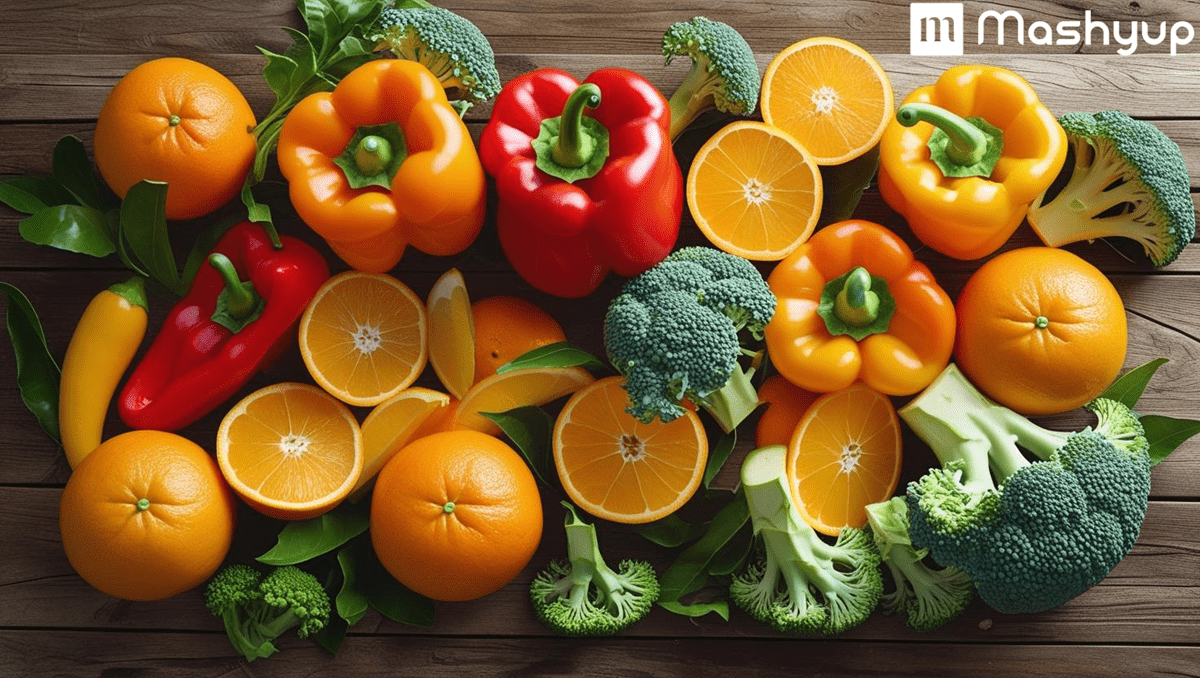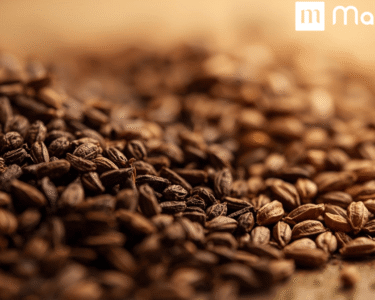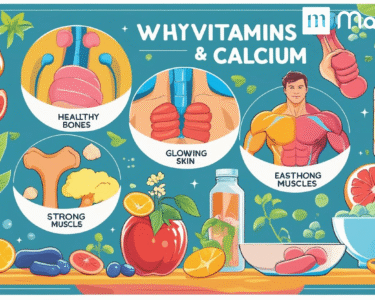Most of us instantly imagine oranges and lemons when we think of vitamin C. However, did you know that a lot of vegetables are also great sources of vitamin C? By including these colorful vegetables on your plate, you may improve the appearance of your skin, boost your immunity, and promote general wellness in a natural way.
Let’s look at some of the best vegetables and fruits that are high in vitamin C that you should on your grocery list, as well as how much vitamin C they provide and some delicious ways to eat them.
Broccoli
Broccoli is one cruciferous vegetable that is packed with many vitamins. Out of all of them, vitamin C holds the highest content. Besides vitamins, broccoli also contains fiber, calcium and vitamin K.
Vitamin C per cup : 81 mg
Ways to eat :
- Steam lightly to keep the nutrients intact.
- Make a healthy broccoli soup
- Add broccoli puree to pasta
Benefits
- Promotes good Heart health as the fiber present in broccoli lowers the bad cholesterol.
- The high fiber content supports excellent gut health
- The Sulforaphane present in broccoli protects the cells against cancer.
- Vitamin C helps ward off colds and supports immunity.
Bell Peppers
Bell Peppers, especially the red ones, are the richest natural source of Vitamin C. It is sweet, crisp and comes loaded with lots of carotenoids, antioxidants, and fiber.
Vitamin C per cup: 190 mg
Ways to eat
- Enjoy it raw in the form of healthy summer salads
- Stuff it with quinoa or other grains for a wholesome meal
- Stir fry it along with other veggies
Benefits
- Contains lutein and zeaxanthin, which protect the eyes.
- Boosts immunity by fighting infections because of the presence of high vitamin C content
- Encourages collagen production and promotes glowing skin.
- Fights free radicals that cause cell damage, reducing inflammation in the body.
Snow Peas
The famous sweet and crunchy snow peas are flat, edible peas that serve as a perfect vitamin C rich snack.
Vitamin C per cup: 38 mg
Ways to eat
- Toss them in salads
- Add to stir fry vegetables
- Have it as a raw snack.
Benefits
- Helps manage weight as it is low in calories and high in fiber
- Offers a lot of vitamin A and antioxidants, which support eye health
- Contains potassium, which regulates blood pressure and supports good heart health
Kale
Kale is a nutrient-packed leafy green vegetable that is packed with numerous nutrients. Often known as a “superfood “ as well for being filled with vitamins A, K, and C, plus the vegetable also has many antioxidants which helps detoxify the body. It has a mild and earthy flavor and is very famous among health conscious people.
Vitamin C per cup: 80 mg
Ways to eat:
- You can blend kale into smoothies.
- Bake Kale chips
- Toss Kale in fresh salads
Benefits:
- Strengthen bones as it is high in calcium and vitamin K
- Vitamin C helps in the production of vitamin C and supports skin health.
- Flush out the toxins through detoxification.
- Effectively fights inflammation in the body.
Cauliflower
You can state cauliflower as one of the most versatile vegetables, as it is mild in flavor. For its high nutrient content and low carbs, it is highly popular among weight conscious people. The veggie is high in vitamin C and also contains lots of fiber and plant based compounds.
Vitamin C cup: 52 mg
Ways to eat:
- Use cauliflower as a rice substitute
- Blend cauliflower for creamy soup
- Roast it with spices
Benefits
- Cauliflower effectively supports heart health.
- It contains choline, which boosts brain function and is essential for memory retention.
- Cauliflower is fulfilling and hence helps in the weight loss journey.
- Sulforaphane present in cauliflower helps promote liver health and helps the body detoxify.
Spinach
One of the most versatile greens, spinach may not have the highest vitamin C content. But if we compare it with other vegetables, its iron, vitamin A and antioxidant content is what makes it an all round nutritious green.
Vitamin C per cup: 8.4 mg
Ways to eat
- Blend it into high protein smoothies
- Stir it into soups
- Ideal option as a curry for a wholesome meal
Benefits
- The presence of lutein and zeaxanthin supports your vision and protects your eyes
- High fiber content promotes gut health
- Vitamin C enhances iron absorption in the body.
- Strengthen bones, for it is rich in vitamin K and calcium.
Cabbage
No matter what type, green or purple, cabbage is a budget friendly source of vitamin C. It is commonly used in many slaws, salads, and fermented foods like sauerkraut and Kimchi as well.
Vitamin C per cup: 32 mg
Ways to eat:
- Shred them onto fresh salad
- Stir fry with other vegetables and spices
- Ferment for gut friendly probiotics
Benefits
- Anti-inflammatory in nature because of the presence of antioxidants
- It may help lower your cholesterol levels as well
- Good vitamin C helps boost immunity and fight infections.
- Promotes gut health as it contains healthy gut bacteria.
Why Should You Eat More Vitamin C Vegetables?
Let’s discuss some of the benefits of vitamin C vegetables:
- Protect heart health
- Fights inflammation and oxidative stress
- Supports iron absorption
- Strengthens immunity naturally
- Contribute to better eye health
- Keeps weight and digestion in check
- Aids in faster healing
Final Words
One of the easiest methods to naturally boost your immune system, maintain youthful skin, and safeguard your heart while eating delectable meals is to eat more veggies high in vitamin C.
Choose a couple of these colorful vegetables and use your imagination in the kitchen the next time you make your shopping list. Your body will appreciate it!






